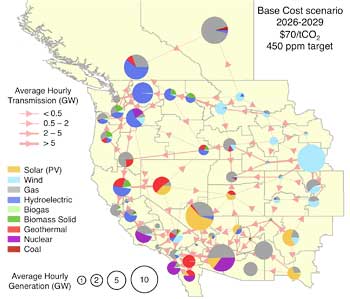Advanced power-grid model finds low-cost, low-carbon future in West
The least expensive way for the Western U.S. to reduce greenhouse gas emissions enough to help prevent the worst consequences of global warming is to replace coal with renewable and other sources of energy that may include nuclear power, according to a new study by University of California, Berkeley, researchers.
The experts reached this conclusion using SWITCH, a highly detailed computer model of the electric power grid for the states west of the Kansas/Colorado border that will be an important tool for utilities and government planners.
“Decarbonization of the electric power sector is critical to achieving greenhouse gas reductions that are needed for a sustainable future,” said Daniel Kammen, Distinguished Professor of Energy in UC Berkeley’s Energy and Resources Group. “To meet these carbon goals, coal has to go away from the region.”

To achieve this level of decarbonization, policy changes are needed to cap or tax carbon emissions to provide an incentive to move toward low-carbon electricity sources, Kammen and the other study authors said.
While some previous studies have emphasized the high cost of carbon taxes or caps, the new study shows that replacing coal with more gas generation, as well as renewable sources like wind, solar and geothermal energy, would result in only a moderate increase to consumers in the cost of electric power – at most, 20 percent. They estimate a lower ratepayer cost, Kammen said, because the evolution of the electrical grid over the next 20 years – with coordinated construction of new power plants and transmission lines – would substantially reduce the actual consumer cost of meeting carbon emission targets.
“While the carbon price required to induce these deep carbon emission reductions is high – between $59 and $87 per ton of CO2 emitted – the cost of power is predicted to increase by at most 20 percent, because the electricity system will redesign itself around a price or cap on carbon emissions,” said Kammen. “That is a modest cost considering that the future of the planet is at stake.”
Coal hazards
Burning coal, a non-renewable resource, produces about 20 percent of the world’s greenhouse gases, but also releases harmful chemicals into the environment such as mercury, sulfur dioxide, nitrogen oxides and sulfuric acid, responsible in some areas for acid rain and respiratory illness.
California has few coal-fired power plants, but gets about 20 percent of its electricity from coal-burning plants in neighboring states. About 46 percent of the state’s power comes from gas-burning plants, 11 percent from hydroelectric, 14 percent from nuclear and 11 percent from other renewables: geothermal energy, wind and solar.
The study, published online this week and scheduled for publication in an upcoming issue of the journal Energy Policy, highlights an analysis using the SWITCH electricity planning model developed in Kammen’s Renewable and Appropriate Energy Laboratory. SWITCH, which stands for Solar, Wind, Hydro and Conventional generation and Transmission Investment, uses unprecedented detail that includes generation, transmission and storage of electricity.
“We use the SWITCH model to identify low-carbon supply options for the West, and to see how intermittent generation may be deployed in the future,” said first author James Nelson, a UC Berkeley graduate student. “We show that it is possible to reach our goals of reducing carbon emissions using many possible mixes of power, whether natural gas, nuclear, solar, wind, biomass or geothermal.”
“Models like this are eagerly anticipated by many of the agencies involved in planning,” Kammen said, noting that the model is now a prototype that could be fine-tuned for specific users.
Setting targets for 2030 emissions
Mandates called Renewable Portfolio Standards (RPS) currently dominate carbon reduction policy in the United States. These standards require that a certain fraction of electricity generation come from renewable sources. While California has a relatively high RPS target of 33 percent renewable sources by 2020, other Western states have less ambitious targets. Additional policy action throughout Western North America will be required to meet climate targets, Kammen said.
The UC Berkeley study concluded that current RPS targets are not sufficient to put electric power sector emissions on track to limit atmospheric levels of carbon to less than 450 ppm, a climate stabilization target recommended by the Intergovernmental Panel on Climate Change. That target requires carbon emissions from electricity production in industrialized countries to drop to no more than 54 percent of 1990 emissions by 2030.
However, the study finds that the right mix of renewable energy sources can meet climate goals given stronger carbon policy.
Of all 50 states, California has been the most aggressive in setting goals for reducing carbon emissions, with a target to return to 1990 levels by 2020. The first step along the path of changing the balance of energy sources is the establishment of a carbon trading market in California, which will be up and running in September 2012, said Kammen.
Coauthors of the study are Josiah Johnston, Ana Mileva, Ian Hoffman, Autumn Petros-Good and Christian Blanco of UC Berkeley’s RAEL lab and the Energy and Resources Group; and Matthias Fripp of the Environmental Change Group at Oxford University in the United Kingdom.
Funding for the Energy Policy study was provided by the National Science Foundation, the Environmental Protection Agency, NextEra Energy Resources, the Karsten Family Foundation, Vestas Wind LLC, the UC Berkeley Class of 1935, the CPV Consortium, the Berkeley Nerds Fellowship and the Link Energy Fellowship.
